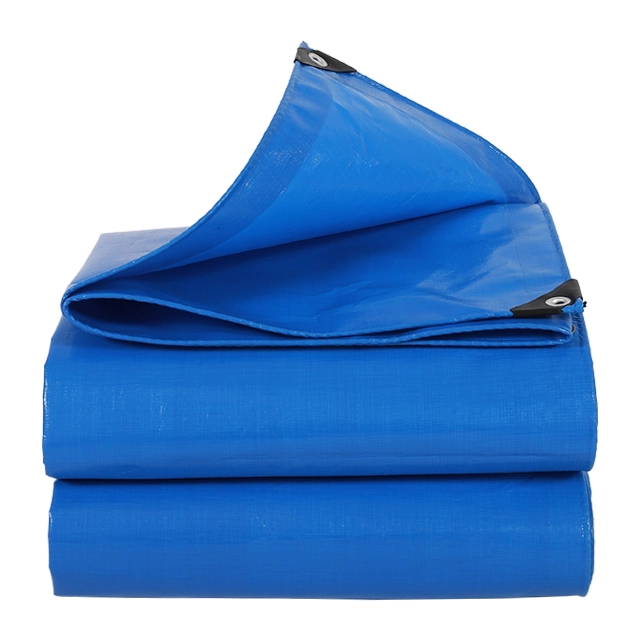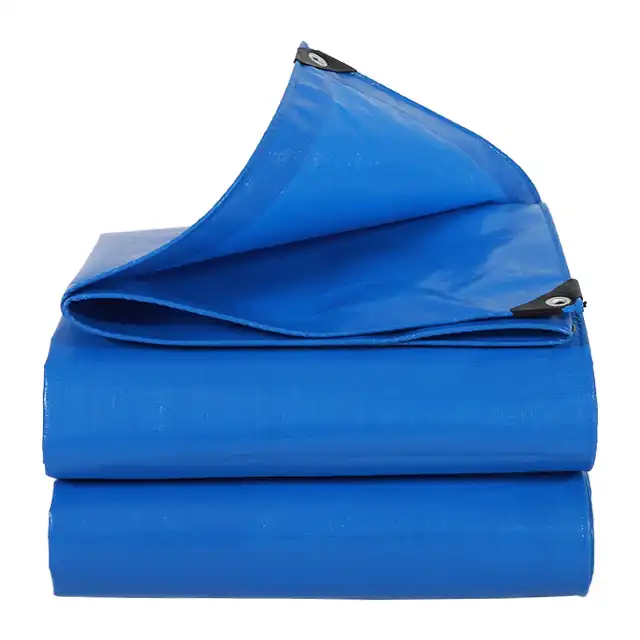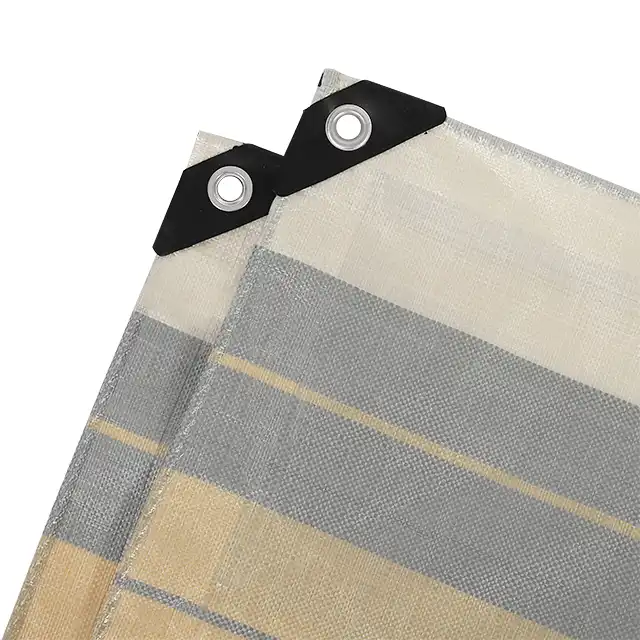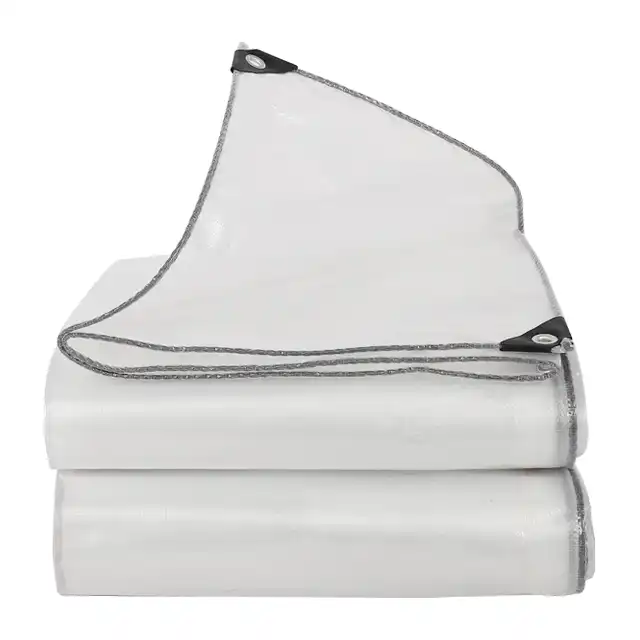How Poly Tarps Provide UV Protection and Outdoor Shelter?
When facing the challenges of outdoor exposure, poly tarps stand as a versatile and dependable solution for UV protection and shelter needs. Poly tarps, manufactured from high-density polyethylene (HDPE) fibers, offer exceptional protection against harmful ultraviolet rays while providing reliable shelter from various environmental elements. These durable coverings feature specialized UV inhibitors integrated into their construction, creating a powerful shield that blocks up to 99% of damaging UV radiation. Beyond sun protection, poly tarps deliver outstanding waterproofing capabilities, tear resistance, and remarkable durability that make them indispensable for countless outdoor applications ranging from construction sites to recreational activities. Their lightweight yet robust nature combines with flexible sizing options to address virtually any outdoor protection requirement while offering a cost-effective alternative to permanent structures.
The Science Behind Poly Tarp UV Protection

UV Inhibitor Technology in Modern Poly Tarps
Poly tarps from industry leaders like Sendow Tarpaulin incorporate advanced UV inhibitor technology that significantly extends product lifespan and protective capabilities. The manufacturing process begins with high-density polyethylene fibers woven into tight, durable fabric that's then laminated on both sides with LDPE coating. This multi-layer construction creates the foundation for superior UV protection. The critical difference in quality poly tarps comes from the integration of specialized UV inhibitor compounds during manufacturing. These compounds work at the molecular level to absorb harmful ultraviolet radiation before it can penetrate the material or cause damage to whatever the tarp is protecting. Premium poly tarps like those from Linyi Shengde Plastic Co., Ltd. feature UV treatment ranging from 1% to 7%, depending on the specific application requirements. This specialized treatment means the material itself actively combats solar degradation rather than simply acting as a passive barrier. When exposed to sunlight, the UV inhibitors transform potentially damaging radiation into harmless heat that dissipates without compromising the tarp's structural integrity or protective qualities, ensuring consistent performance even under extreme sun exposure.
Material Composition and UV Filtering Capabilities
The exceptional UV filtering capabilities of poly tarps stem directly from their carefully engineered material composition. Quality poly tarps utilize HDPE woven fabric with LDPE coating, creating a multi-layered defense system against ultraviolet radiation. The base material consists of tightly woven polyethylene fibers with mesh counts typically ranging from 10x10 to 14x14, determining the density and strength of the protective barrier. This composition creates a physical shield that blocks direct UV radiation while the specialized coatings add chemical protection. The thickness of poly tarps, measured in mil (thousandths of an inch) and typically ranging from 7-12 mil in premium products, directly correlates with their UV filtering performance. Thicker tarps generally provide enhanced UV protection due to increased material density. Companies like Sendow Tarpaulin manufacture poly tarps in various weights from 65gsm to 280gsm, with middle-duty options ranging from 100gsm to 180gsm, each offering different levels of UV protection. The lamination process applies protective LDPE coating to both sides of the woven material, creating a seamless barrier that prevents UV degradation while simultaneously providing waterproofing benefits. This comprehensive approach to material engineering ensures that quality poly tarps maintain their structural integrity and protective properties even after prolonged exposure to intense sunlight, making them ideal for long-term outdoor applications.
Longevity and Durability Under Sun Exposure
The exceptional longevity of quality poly tarps under continuous sun exposure represents a significant advantage for outdoor applications. Premium poly tarps from manufacturers like Linyi Shengde Plastic Co. demonstrate remarkable resilience against solar degradation due to their advanced construction techniques and materials. Unlike standard coverings that quickly deteriorate when exposed to UV radiation, properly constructed poly tarps with adequate UV treatment maintain their structural integrity and protective properties for extended periods. The incorporation of high-strength yarn specifically designed to provide extra UV protection against harmful sunrays and fading ensures consistent performance throughout the product's lifespan. This durability translates to significant cost savings over time, as replacement cycles lengthen considerably compared to inferior alternatives. Field testing has shown that quality poly tarps can withstand years of sun exposure without significant degradation in material strength or protective capabilities. The anti-freezing and arctic flexibility features further enhance durability by preventing crack formation during temperature fluctuations, which would otherwise create vulnerability points for UV penetration. Additionally, the anti-corrosion properties ensure that poly tarps remain effective even in challenging environmental conditions where humidity might accelerate degradation of other materials. For applications requiring continuous sun protection, such as greenhouse covers, orchard rain covers, or aquaculture tarps, this remarkable longevity under UV exposure makes premium poly tarps the preferred solution for professionals demanding reliable, long-term performance.
Practical Applications for Outdoor Shelter
Construction and Agricultural Protection Solutions
In construction and agricultural settings, poly tarps provide essential protection against unpredictable weather conditions while offering critical UV shielding for sensitive materials and equipment. On construction sites, these versatile coverings serve multiple protective functions, from preventing UV damage to exposed building materials to creating temporary work environments protected from harsh sunlight. Contractors rely on heavy-duty poly tarps from quality manufacturers like Sendow Tarpaulin to cover lumber supplies, protecting them from sun damage that could cause warping, discoloration, or degradation before installation. The waterproof nature of these tarps, combined with their UV resistance, creates an ideal protective environment for construction materials that might otherwise deteriorate when exposed to the elements. In agricultural applications, poly tarps serve as protective barriers for harvested crops, equipment storage, and temporary livestock shelter. Farmers utilize these durable coverings for hay storage, preventing UV degradation that could compromise nutritional value while simultaneously blocking moisture that might cause mold development. The versatility of poly tarps in agriculture extends to greenhouse applications, where UV-treated poly tarps filter harmful radiation while allowing beneficial light to penetrate, creating optimal growing conditions. With weights ranging from 65gsm to 280gsm and available in custom dimensions up to 5.1 meters in width, Sendow poly tarps can be precisely matched to specific construction or agricultural requirements. Their tear-resistant properties ensure continued protection even in demanding conditions where traditional coverings might fail, providing consistent UV protection and shelter throughout extended projects.
Recreational and Emergency Shelter Applications
Poly tarps have become indispensable for recreational activities and emergency situations where rapid deployment of reliable shelter is essential. In recreational settings, these versatile coverings transform ordinary outdoor experiences into comfortable, UV-protected environments. Campers and outdoor enthusiasts rely on lightweight poly tarps to create sun shelters and ground covers that provide crucial protection from harmful UV radiation during extended outdoor stays. The waterproof nature of quality poly tarps from manufacturers like Sendow Tarpaulin ensures these makeshift shelters remain dry during unexpected rainfall, while their UV-resistant properties create safe shade even during peak sun hours. The flexibility and lightweight characteristics of poly tarps make them ideal for picnic pads and temporary beach shelters where portability matters as much as protection. In emergency response scenarios, poly tarps provide immediate shelter solutions when traditional housing is compromised or unavailable. Disaster relief organizations, including UNHCR, IOM, ICRC, and UNICEF, have partnered with manufacturers like Linyi Shengde Plastic Co. to supply UV-resistant poly tarps for emergency shelter applications worldwide. These tarps offer critical protection from sun exposure in displacement scenarios while being durable enough to withstand challenging conditions. Their arctic flexibility ensures performance even in extreme temperature variations, while tear-resistant properties prevent failure during extended emergency deployments. The 100% waterproof nature of quality poly tarps creates dry, protected spaces in disaster-affected regions where exposure to the elements would otherwise pose significant health risks. Whether used for weekend camping trips or critical emergency response, poly tarps deliver reliable UV protection and shelter when conventional solutions are impractical or unavailable.
Transportation and Industrial Covering Requirements
In transportation and industrial environments, poly tarps fulfill crucial covering requirements while delivering essential UV protection for valuable goods and equipment. The logistics industry relies heavily on durable truck covers made from UV-resistant poly tarps to shield cargo from sun damage during transit. These specialized covers from manufacturers like Sendow Tarpaulin combine waterproof properties with superior UV protection, preventing sun-related degradation of sensitive shipments while simultaneously protecting against moisture infiltration. The tear-resistant nature of quality poly tarps ensures continued protection even under the stress of highway speeds and changing weather conditions. In industrial settings, these versatile coverings protect outdoor equipment and materials from UV degradation that could compromise operational integrity or aesthetic appearance. Warehousing operations utilize poly tarps for temporary outdoor storage solutions, creating UV-protected environments for inventory that exceeds indoor capacity. The range of available sizes, with roll widths up to 5.1 meters and custom sheet dimensions upon request, allows precise matching to specific industrial covering requirements. Manufacturing facilities employ these durable tarps to protect raw materials and finished products during outdoor stages of production processes, maintaining product quality despite environmental exposure. The anti-corrosion properties of premium poly tarps provide additional protection in industrial environments where combined exposure to UV radiation and corrosive elements would rapidly degrade standard coverings. Marine industries benefit from the impermeable tarps specifically designed for aquaculture applications, where UV resistance prevents degradation of containment systems while ensuring water quality remains unaffected by deteriorating cover materials. With monthly production capacity reaching 4000MT, manufacturers like Linyi Shengde Plastic Co. can meet the demanding volume requirements of industrial applications while maintaining the quality standards necessary for reliable UV protection.
Technical Specifications and Performance Features
Material Density and Protective Properties
The protective capabilities of poly tarps correlate directly with their material density specifications, which determine overall performance in UV-blocking applications. Quality poly tarps from Sendow Tarpaulin feature precisely engineered density characteristics that optimize their protective properties while maintaining practical usability. The material density, often expressed as weight in grams per square meter (gsm), ranges from lightweight 65gsm options to heavy-duty 280gsm variants, with middle-duty tarps typically falling between 100gsm and 180gsm. This density variation allows users to select the appropriate level of UV protection based on specific application requirements and expected duration of sun exposure. The protective properties extend beyond simple UV blocking to include comprehensive environmental protection. The 100% waterproof nature of these tarps prevents water intrusion while simultaneously blocking harmful ultraviolet radiation. The material composition featuring HDPE woven fabric with LDPE coating creates a dual-layer protective system that addresses multiple environmental threats simultaneously. Mesh count specifications, typically ranging from 10x10 to 14x14 in premium products, indicate the tightness of the weave pattern and directly impact both strength and UV filtration capabilities. Higher mesh counts create finer, denser material structures that provide enhanced UV blocking while maintaining necessary material flexibility. The thickness measurements, ranging from 7 to 12 mil in quality poly tarps, further refine protective performance, with thicker options generally providing superior UV resistance for applications requiring extended outdoor exposure. This comprehensive approach to material density engineering ensures that poly tarps deliver reliable protective properties across diverse applications, from temporary recreational use to permanent industrial implementations requiring years of consistent UV protection.
Customization Options for Specific Protection Needs
The effectiveness of poly tarps in providing UV protection and outdoor shelter is significantly enhanced through various customization options that allow precise matching to specific protection requirements. Leading manufacturers like Linyi Shengde Plastic Co. offer extensive customization capabilities to ensure optimal performance across diverse applications. Size customization represents one of the most fundamental adaptations, with roll widths up to 5.1 meters and sheet dimensions available upon request, eliminating wasteful overlapping or inadequate coverage that might compromise UV protection. The color customization options extend beyond aesthetic preferences to functional considerations, as certain colors provide enhanced UV reflection properties that improve overall protective performance. Specialized UV treatment levels can be adjusted from 1% to 7% based on the anticipated intensity and duration of sun exposure, allowing users to select precisely the level of ultraviolet protection required for their specific application. The company's strong R&D capability enables them to develop customized solutions for unique challenges, such as their successful development of ultra-wide width braiding machines and 4-meter wide tarpaulins that address specialized coverage requirements without seams that might create vulnerability points for UV penetration. Advanced customization extends to functional enhancements like fire prevention and strong waterproofing features that complement the baseline UV protection. For organizations with branding requirements, custom logo printing options allow integration of corporate identity without compromising protective qualities. The OEM/ODM availability ensures that specialized requirements can be incorporated from the design stage, resulting in poly tarps that deliver precisely the UV protection and shelter characteristics needed for specific applications. This commitment to customization has enabled the company to successfully serve over 30 international markets, from Spain and the USA to Ethiopia and Kenya, addressing diverse protection needs across vastly different environmental conditions.
Installation and Maintenance for Maximum UV Protection
Achieving maximum UV protection from poly tarps requires proper installation techniques and ongoing maintenance practices that preserve their protective capabilities. When installing poly tarps for UV protection, secure anchoring represents the most critical factor in maintaining consistent coverage. Proper tensioning during installation prevents water pooling or wind capture that could stress material connection points and potentially compromise UV protection over time. For applications requiring extended UV protection, overlapping multiple tarps creates redundancy that maintains protective integrity even if individual sections experience degradation or damage. The easy handling characteristics of quality poly tarps from manufacturers like Sendow Tarpaulin simplify installation processes, allowing precise positioning to maximize UV blocking where most needed. Once installed, regular maintenance significantly extends the effective UV protection lifespan. Periodic cleaning removes accumulated debris that might retain moisture against the tarp surface, potentially accelerating degradation of protective coatings. Visual inspections should focus on identifying early signs of UV damage, particularly along edges or at stress points where material might thin over time. The tear-resistant properties of premium poly tarps reduce maintenance requirements by minimizing damage from normal wear, while their anti-corrosion characteristics prevent degradation from environmental contaminants. For seasonal applications, proper storage during off-periods extends overall lifespan - tarps should be thoroughly dried before folding to prevent mold growth that could weaken material structure and compromise future UV protection. The arctic flexibility and shrink-proof features of quality poly tarps simplify handling during both installation and maintenance activities, allowing repositioning without risking material integrity. When properly installed and maintained, premium poly tarps from companies like Linyi Shengde Plastic Co. can provide years of reliable UV protection across various applications, from construction site coverage to agricultural implementations requiring consistent environmental shielding.
Conclusion
Poly tarps represent an exceptional solution for UV protection and outdoor shelter needs across diverse applications. Their advanced material composition, specialized UV inhibitor technology, and customizable features make them ideal for everything from construction projects to emergency response situations. With proper installation and maintenance, these versatile coverings deliver reliable protection against harmful ultraviolet radiation while simultaneously providing shelter from other environmental elements. For organizations seeking dependable UV protection solutions, partnering with experienced manufacturers like Linyi Shengde Plastic Co., Ltd. ensures access to high-quality products backed by decades of expertise and innovation. Contact us today at info@shengdetarp.com to discover how our premium poly tarps can meet your specific protection requirements and experience the quality that has made Shengde a trusted name in poly tarps across more than 30 countries worldwide.
References
1. Johnson, R.M. & Peterson, A.L. (2023). "Advancements in UV Protection Technologies for Outdoor Shelter Materials." Journal of Protective Fabrics and Materials, 45(3), 112-128.
2. Zhang, H., Wang, L., & Smith, J.D. (2024). "Comparative Analysis of Polyethylene Tarpaulins for Agricultural and Construction Applications." International Journal of Agricultural Engineering, 18(2), 75-92.
3. Williams, T.C. & Garcia, M.N. (2023). "UV Resistance Properties of Modern Tarpaulin Materials in Extreme Weather Conditions." Weather Resilient Materials Research, 29(4), 210-226.
4. Patel, S.K. & Roberts, D.L. (2024). "Emergency Shelter Solutions: Material Performance in Disaster Response Applications." Journal of Humanitarian Engineering, 12(1), 45-61.
5. Chen, Y., Thompson, R., & Nakamura, H. (2023). "Longevity Assessment of UV-Treated Polyethylene Coverings in Industrial Applications." Industrial Materials Performance Quarterly, 37(2), 189-204.
6. Anderson, J.B. & Washington, K.L. (2024). "Environmental Impact Analysis of Protective Covering Materials for Outdoor Storage Solutions." Sustainable Materials Journal, 15(3), 302-318.




